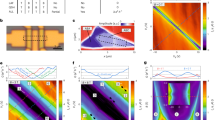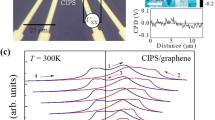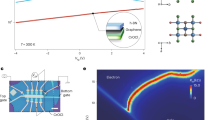Abstract
There are two known distinct types of the integer quantum Hall effect. One is the conventional quantum Hall effect, characteristic of two-dimensional semiconductor systems1,2, and the other is its relativistic counterpart observed in graphene, where charge carriers mimic Dirac fermions characterized by Berry’s phase π, which results in shifted positions of the Hall plateaus3,4,5,6,7,8,9. Here we report a third type of the integer quantum Hall effect. Charge carriers in bilayer graphene have a parabolic energy spectrum but are chiral and show Berry’s phase 2π affecting their quantum dynamics. The Landau quantization of these fermions results in plateaus in Hall conductivity at standard integer positions, but the last (zero-level) plateau is missing. The zero-level anomaly is accompanied by metallic conductivity in the limit of low concentrations and high magnetic fields, in stark contrast to the conventional, insulating behaviour in this regime. The revealed chiral fermions have no known analogues and present an intriguing case for quantum-mechanical studies.
This is a preview of subscription content, access via your institution
Access options
Subscribe to this journal
Receive 12 print issues and online access
$259.00 per year
only $21.58 per issue
Buy this article
- Purchase on SpringerLink
- Instant access to full article PDF
Prices may be subject to local taxes which are calculated during checkout



Similar content being viewed by others
References
Prange, R. E. & Girvin, S. M. The Quantum Hall Effect (Springer, New York, 1990).
Macdonald, A. H. Quantum Hall Effect: A Perspective (Kluwer Academic, Dordrecht, 1990).
Novoselov, K. S. et al. Two-dimensional gas of massless Dirac fermions in graphene. Nature 438, 197–200 (2005).
Zhang, Y., Tan, J. W., Stormer, H. L. & Kim, P. Experimental observation of the quantum Hall effect and Berry’s phase in graphene. Nature 438, 201–204 (2005).
McClure, J. W. Diamagnetism of graphite. Phys. Rev. 104, 666–671 (1956).
Haldane, F. D. M. Model for a quantum Hall effect without Landau levels: Condensed-matter realization of the ‘parity anomaly’. Phys. Rev. Lett. 61, 2015–2018 (1988).
Zheng, Y. & Ando, T. Hall conductivity of a two-dimensional graphite system. Phys. Rev. B 65, 245420 (2002).
Gusynin, V. P. & Sharapov, S. G. Unconventional integer quantum Hall effect in graphene. Phys. Rev. Lett. 95, 146801 (2005).
Peres, N. M. R., Guinea, F. & Castro Neto, A. H. Electronic properties of two-dimensional carbon. Preprint at <http://arxiv.org/abs/cond-mat/0506709> (2005).
Novoselov, K. S. et al. Electric field effect in atomically thin carbon films. Science 306, 666–669 (2004).
Novoselov, K. S. et al. Two dimensional atomic crystals. Proc. Natl Acad. Sci. USA 102, 10451–10453 (2005).
Wallace, P. R. The band theory of graphite. Phys. Rev. 71, 622–634 (1947).
Dresselhaus, M. S. & Dresselhaus, G. Intercalation compounds of graphite. Adv. Phys. 51, 1–186 (2002).
Trickey, S. B., Müller-Plathe, F., Diercksen, G. H. F. & Boettger, J. C. Interplanar binding and lattice relaxation in a graphite delayer. Phys. Rev. B 45, 4460–4468 (1992).
McCann, E. & Falko, V. I. Landau level degeneracy and quantum Hall effect in a graphite bilayer. Preprint at <http://arxiv.org/abs/cond-mat/0510237> (2005).
Berry, M. V. Quantal phase factor accompanying adiabatic change. Proc. R. Soc. Lond. A 392, 45–57 (1984).
Acknowledgements
We thank the High Field Magnet Laboratory (Nijmegen) for their hospitality. U.Z. and K.S.N. were partially supported by EuroMagNET of the 6th Framework ‘Structuring the European Research Area, Research Infrastructures Action’ and by the Leverhulme Trust. S.V.M. acknowledges support from the Russian Academy of Sciences. This research was funded by the EPSRC (UK).
Author information
Authors and Affiliations
Corresponding author
Ethics declarations
Competing interests
The authors declare no competing financial interests.
Supplementary information
41567_2006_BFnphys245_MOESM1_ESM.pdf
Supplementary Information: J-fold degeneracy of the lowest Landau level for chiral fermions described by Hamiltonian (PDF 29 kb)
Rights and permissions
About this article
Cite this article
Novoselov, K., McCann, E., Morozov, S. et al. Unconventional quantum Hall effect and Berry’s phase of 2π in bilayer graphene. Nature Phys 2, 177–180 (2006). https://doi.org/10.1038/nphys245
Received:
Accepted:
Published:
Issue date:
DOI: https://doi.org/10.1038/nphys245
This article is cited by
-
Impurity atoms effects on electronic properties and Seebeck coefficient of armchair graphene like nanoribbon
Applied Physics A (2024)
-
Thermally stable quantum Hall effect in a gated ferroelectric-graphene heterostructure
Communications Physics (2023)
-
Electro-static properties of GaAs based two-dimensional bilayer systems
Indian Journal of Physics (2023)
-
High current limits in chemical vapor deposited graphene spintronic devices
Nano Research (2023)
-
The influence of single carbon atom impurity on the electronic transport of (6, 3) two side-closed single-walled boron nitride nanotubes
Journal of Molecular Modeling (2023)



